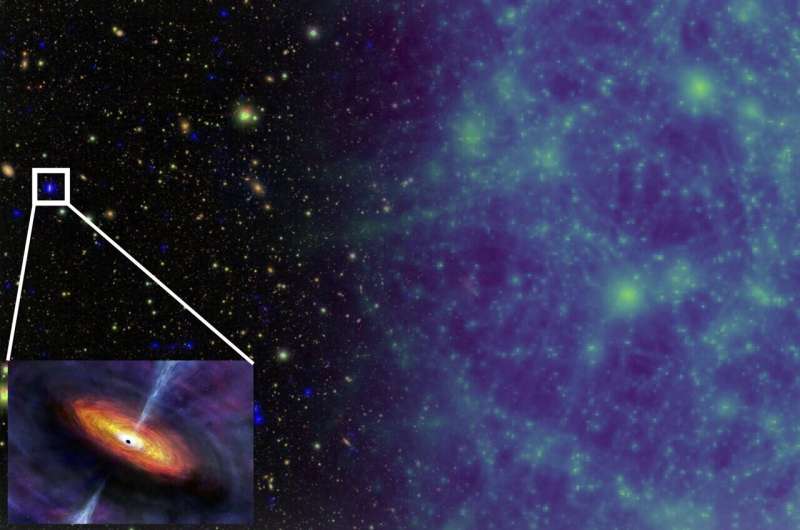This article has been reviewed according to Science X's editorial process and policies. Editors have highlighted the following attributes while ensuring the content's credibility:
fact-checked
peer-reviewed publication
trusted source
proofread
Combined X-ray surveys and supercomputer simulations track 12 billion years of cosmic black-hole growth

By combining forefront X-ray observations with state-of-the-art supercomputer simulations of the buildup of galaxies over cosmic history, researchers have provided the best modeling to date of the growth of the supermassive black holes found in the centers of galaxies. Using this hybrid approach, a research team led by Penn State astronomers has derived a complete picture of black-hole growth over 12 billion years, from the universe's infancy at around 1.8 billion years old to now at 13.8 billion years old.
Two papers comprise the research, one published in The Astrophysical Journal, and one as yet unpublished that will be submitted to the same journal. The results will be presented at the 244th meeting of the American Astronomical Society, held June 9 through June 13 at the Monona Terrace Convention Center in Madison, Wisconsin.
"Supermassive black holes in galaxy centers have millions-to-billions of times the mass of the sun," said Fan Zou, a graduate student at Penn State and first author of the papers. "How do they become such monsters? This is a question that astronomers have been studying for decades, but it has been difficult to track all the ways black holes can grow reliably."
Supermassive black holes grow through a combination of two main channels. They consume cold gas from their host galaxy—a process called accretion—and they can merge with other supermassive black holes when galaxies collide.
"During the process of consuming gas from their hosting galaxies, black holes radiate strong X-rays, and this is the key to tracking their growth by accretion," said W. Niel Brandt, Eberly Family Chair Professor of Astronomy and Astrophysics and professor of physics at Penn State and a leader of the research team. "We measured the accretion-driven growth using X-ray sky survey data accumulated over more than 20 years from three of the most powerful X-ray facilities ever launched into space."
The research team used complementary data from NASA's Chandra X-ray Observatory, the European Space Agency's X-ray Multi-Mirror Mission-Newton (XMM-Newton), and the Max Planck Institute for Extraterrestrial Physics' eROSITA telescope. In total, they measured the accretion-driven growth in a sample of 1.3 million galaxies that contained over 8,000 rapidly growing black holes.
"All of the galaxies and black holes in our sample are very well characterized at multiple wavelengths, with superb measurements in the infrared, optical, ultraviolet, and X-ray bands," Zou said. "This allows for robust conclusions, and the data show that, at all cosmic epochs, more massive galaxies grew their black holes by accretion faster. With the quality of the data, we were able to quantify this important phenomenon much better than in past works."
The second way that supermassive black holes grow is through mergers, where two supermassive black holes collide and merge together to form a single, even more massive, black hole. To track growth by mergers, the team used IllustrisTNG, a set of supercomputer simulations that model galaxy formation, evolution, and merging from shortly after the Big Bang until the present.
"In our hybrid approach, we combine the observed growth by accretion with the simulated growth through mergers to reproduce the growth history of supermassive black holes," Brandt said. "With this new approach, we believe we have produced the most realistic picture of the growth of supermassive black holes up to the present day."
The researchers found that in most cases, accretion dominated black-hole growth. Mergers made notable secondary contributions, especially over the past 5 billion years of cosmic time for the most-massive black holes. Overall, supermassive black holes of all masses grew much more rapidly when the universe was younger. Because of this, the total number of supermassive black holes was almost settled by 7 billion years ago, while earlier in the universe many new ones kept emerging.
"With our approach, we can track how central black holes in the local universe most likely grew over cosmic time," Zou said. "As an example, we considered the growth of the supermassive black hole in the center of our Milky Way galaxy, which has a mass of 4 million solar masses. Our results indicate that our galaxy's black hole most likely grew relatively late in cosmic time."
In addition to Zou and Brandt, the research team includes Zhibo Yu, graduate student at Penn State; Hyungsuk Tak, assistant professor of statistics and of astronomy and astrophysics at Penn State; Elena Gallo at the University of Michigan; Bin Luo at Nanjing University in China; Qingling Ni at the Max Planck Institute for Extraterrestrial Physics in Germany; Yongquan Xue at the University of Science and Technology of China; and Guang Yang at the University of Groningen in the Netherlands.
More information: Fan Zou et al, Mapping the Growth of Supermassive Black Holes as a Function of Galaxy Stellar Mass and Redshift, The Astrophysical Journal (2024). DOI: 10.3847/1538-4357/ad27cc
Journal information: Astrophysical Journal
Provided by Pennsylvania State University





















